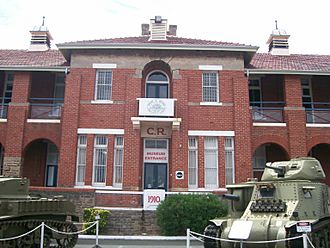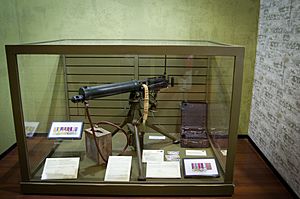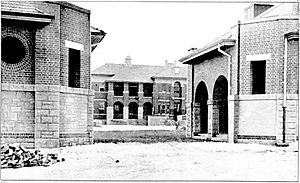Army Museum of Western Australia facts for kids
Quick facts for kids Victoria Barracks |
|
|---|---|

The main entrance to the Army Museum of Western Australia
|
|
| Alternative names | Army Museum of Western Australia |
| General information | |
| Architectural style | Federation Free Classical |
| Location | Fremantle, Western Australia |
| Address | Burt Street (corner Queen Victoria Street) |
| Coordinates | 32°2′42.74″S 115°45′15.84″E / 32.0452056°S 115.7544000°E |
| Current tenants | Army Museum of Western Australia |
| Construction started | 1910 |
| Completed | 1956 |
| Owner | Department of Defence |
| Design and construction | |
| Architect | Hillson Beasley |
| Architecture firm | Public Works Department of Western Australia |
| Structural engineer | Public Works Department of Western Australia |
| Main contractor | Carrick, T.F. |
| References | |
| Official name | Artillery Barracks |
| Type | Listed place (Historic) |
| Designated | 22 June 2004 |
| Reference no. | 105332 |
| Official name | Artillery Barracks & Fremantle Harbour Signal Station (former) |
| Designated | 2 September 1997 |
| Reference no. | 991 |
The Army Museum of Western Australia is a cool museum in Fremantle, Western Australia. It's inside an old building called the Artillery Barracks on Burt Street. This museum opened in 1977. You can see some really special awards there, including three Victoria Crosses!
Contents
History of the Army Museum
The Army Museum of Western Australia first opened its doors in 1977. It was originally located in a 19th-century building called Dilhorn House in Perth. In 1995, the museum moved to its current home. This new location is the historic Artillery Barracks in Fremantle.
The Artillery Barracks: A Military Home
The land for the Fremantle Artillery Barracks was bought in 1909. It cost £3,000, which would be a lot of money today! The barracks were built between 1910 and 1913. They were designed to be the main base for the Royal Australian Garrison Artillery. These soldiers operated the big guns that protected the port of Fremantle.
The main idea for the buildings came from Hillson Beasley. He was the Government Architect at the Public Works Department of Western Australia. The barracks are made of red brick and limestone. They were built in a style called Federation Free Classical. The buildings were made to house 120 soldiers and officers. Their job was to protect the harbour and ships.
The location of the barracks was chosen carefully. Military leaders like Talbot Hobbs believed that enemies would attack by sea, not from the air. The Artillery Barracks helped support two other forts nearby. These forts were part of Fremantle Harbour's defenses before World War I.
Building the Barracks: Two Stages
The first part of the barracks was built in 1910. This included a two-story building for 40 soldiers. It also had an Orderly Room, Guard Room, and a Quarter Store. There was a separate kitchen and a gymnasium. All these buildings faced a parade ground.
Three years later, more buildings were added. These included a second barracks block, homes for married soldiers, and officers' quarters. A hospital was also built, which later became the Sergeants' Mess. A large grassy area was used for horses.
Barracks During Wartime
When World War I started in 1914, the barracks changed. They were used as hospital wards. First, they cared for sick new soldiers of the First Australian Imperial Force. Then, they helped wounded soldiers recovering from the Western Front. This continued for a year after the war ended.
Between the two World Wars, some new work buildings were added. These included sheds and garages. In 1928, a wooden signal tower was built. It took over from an older signal station.
After World War II, a high-ranking officer, Major General John Whitelaw, lived in the Commanding Officer's Quarters. This home was known as Gun House. It became a tradition for the most senior officer to live there. Since 1946, eighteen regional commanders have lived at the site. From 1948, the barracks mainly trained soldiers for the Citizen Military Forces. This group later became the Australian Army Reserves.
In 1956, a new signal station was built on top of Cantonment Hill. It was made of stone and replaced the old wooden one. This station was used by the Fremantle Harbour Trust Commission. However, it only operated for eight years. New grain silos blocked its view, so a new station was built elsewhere. The Cantonment Hill station was then given back to the Army.
Museum Galleries and Displays
The museum has many different galleries. Each gallery shows how the Army has been involved in Western Australia. They also highlight the military service of people from Western Australia. This covers history from the early colonial days right up to today.
The museum has seven main galleries:
- Pre-1914 Gallery
- World War I Gallery and Trench scene
- World War II Gallery
- Prisoner of War Gallery
- Post-1945 Gallery
- Vehicles and weapons
- Museum grounds
Special Items at the Museum

The museum has many important items in its collection. Some of the most significant include:
- Three Victoria Crosses. These are the highest awards for bravery in the military. They were given to Western Australians: Martin O'Meara, Percival Eric Gratwick, and Leslie Thomas Starcevich.
- A Military Medal (MM) given to a Nursing Sister during World War I. Only seven Australian nurses received this award.
- A Distinguished Service Order (DSO) awarded to an officer from the 44th Battalion.
- A Distinguished Conduct Medal and MM group from a soldier in the 1st AIF.
- Two Military Medals awarded to brothers.
- A DCM given to a soldier from the 10th Light Horse for fighting in World War I.
- A DCM awarded to a 2/16th Battalion soldier who died of wounds during the Battle of Buna-Gona.
- A DCM awarded to a 2/16th Battalion soldier for the Battle of Shaggy Ridge.
- A DSO awarded to Major Jack Gerke from 3RAR for the Battle of Maryang San.
- A collection of Queen's South Africa Medals and other medals. These were given to members of the Western Australian Mounted Infantry.
- A group of campaign medals given to a Western Australian nurse. She was sadly killed by the Japanese during World War II.


